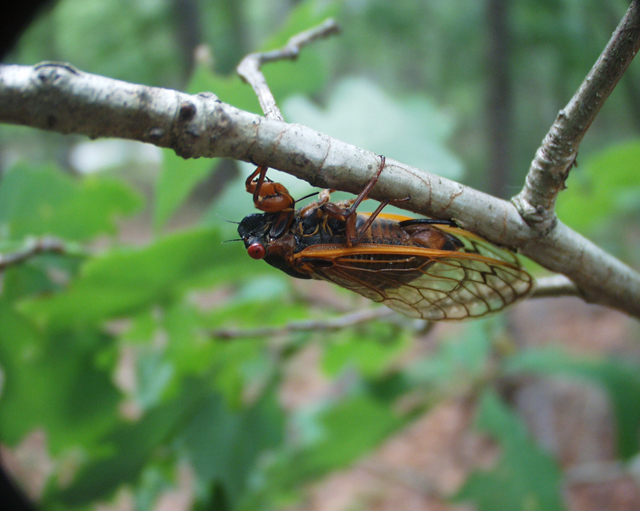Cicadas return to Wildwood State Park in Wading River


A type of cicada that has only appeared in a few states was recently spotted at Wildwood State Park in Wading River.
The last time local residents heard the humming of these periodical cicadas, which are called Magicicada septendecim, was in 1999. Scientists say the insects started to emerge from underground over Memorial Day weekend.
Though they are usually consistent in their emergence once every 17 years, sometimes they appear a few years earlier or later, said Chris Simon, professor in the department of ecology and evolutionary biology at the University of Connecticut.
“This happens rarely,” she explained about the cicadas reappearing off schedule, “but we suspect it happens when there are long lasting temperature anomalies affecting their growing season.”
Each time a large group comes out together, they are classified as a “brood.” The group emerging this year is Brood V, which has also appeared in Ohio, West Virginia, Pennsylvania and Virginia.
Cicadas spend a portion of their lives under ground feeding off of fluid from tree roots. When they feel the ground is finally warm enough, they emerge in order to reproduce. The insects remain aboveground for about 4 to 6 weeks after they first start emerging.
In addition to Wildwood State Park, Ms. Simon said cicadas have also appeared in Calverton National Cemetery and nearby Otis Pike Preserve where birds have been feeding on them.
“We were worried that the entire Long Island population of Brood V might disappear,” she said. “That would be a tragedy.”
No other insect lives as long — or has such a precise emergence schedule — as the 17-year cicadas, she added.
The insects are very distinguishable: black bodies with bright red eyes and orange veins in their wings, according to magicicada.org, a website that maps out the species. In addition, cicadas have no defense mechanism, making them incapable of hurting humans.
Dan Gilrein, an entomologist with Cornell Cooperative Extension in Riverhead, described them as “beautiful” and said they don’t pose any real threat to the ecosystem. He added cicadas are important because they provide food for other animals and also introduce nutrients to the soil when they die.
Ms. Simon said the only damage they may cause is to small trees when large populations lay eggs in the branches and twigs. However, she said, the trees are could easily be protected with nets traditionally used to keep birds off.
“For the most part, the damage is relatively minor,” Mr. Gilrein said.
“Cicadas are very charismatic,” Ms. Simon added.
Long Island’s largest brood is Brood XIV, which last appeared in 2008 and is expected to return in 2025.
Photo: Scientists say cicadas have no defense mechanism, making them incapable of hurting humans. (Credit: Dan Gilrein, courtesy)








